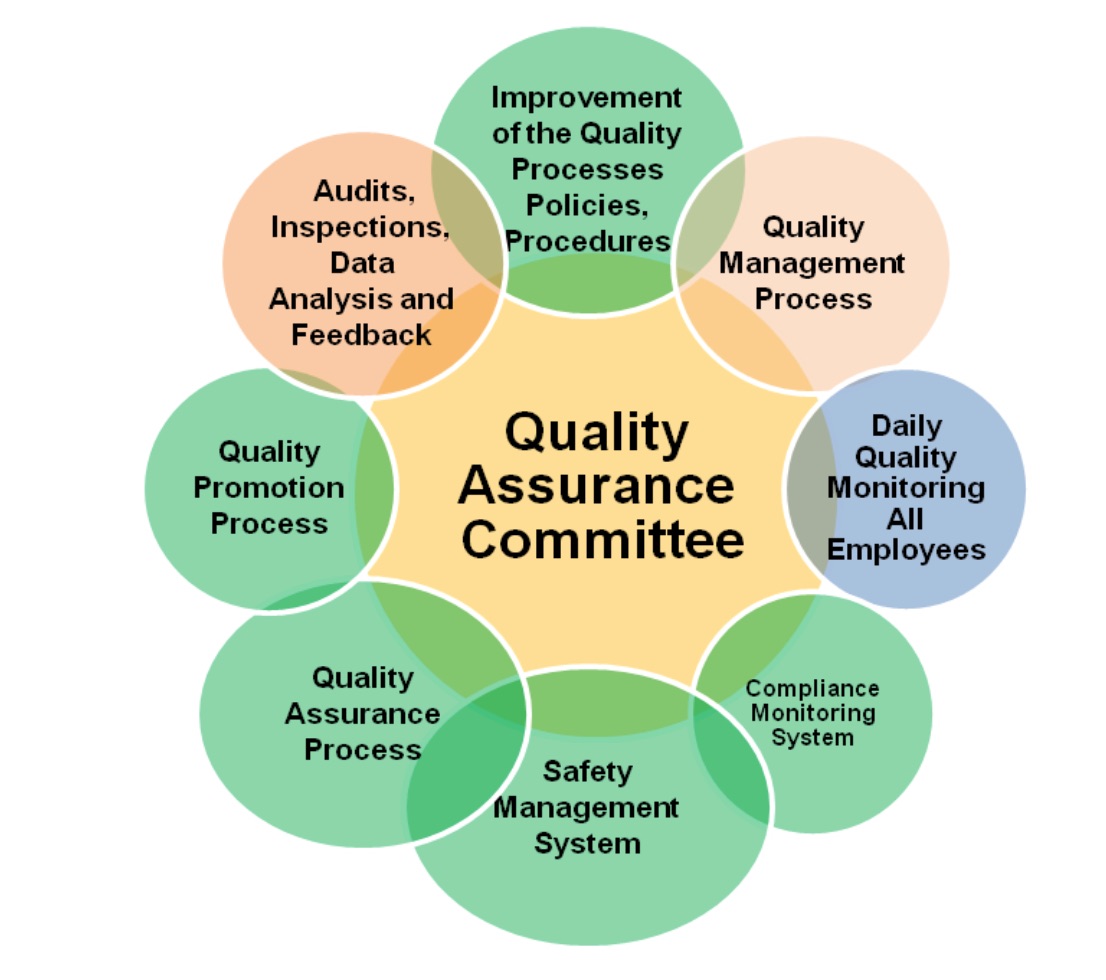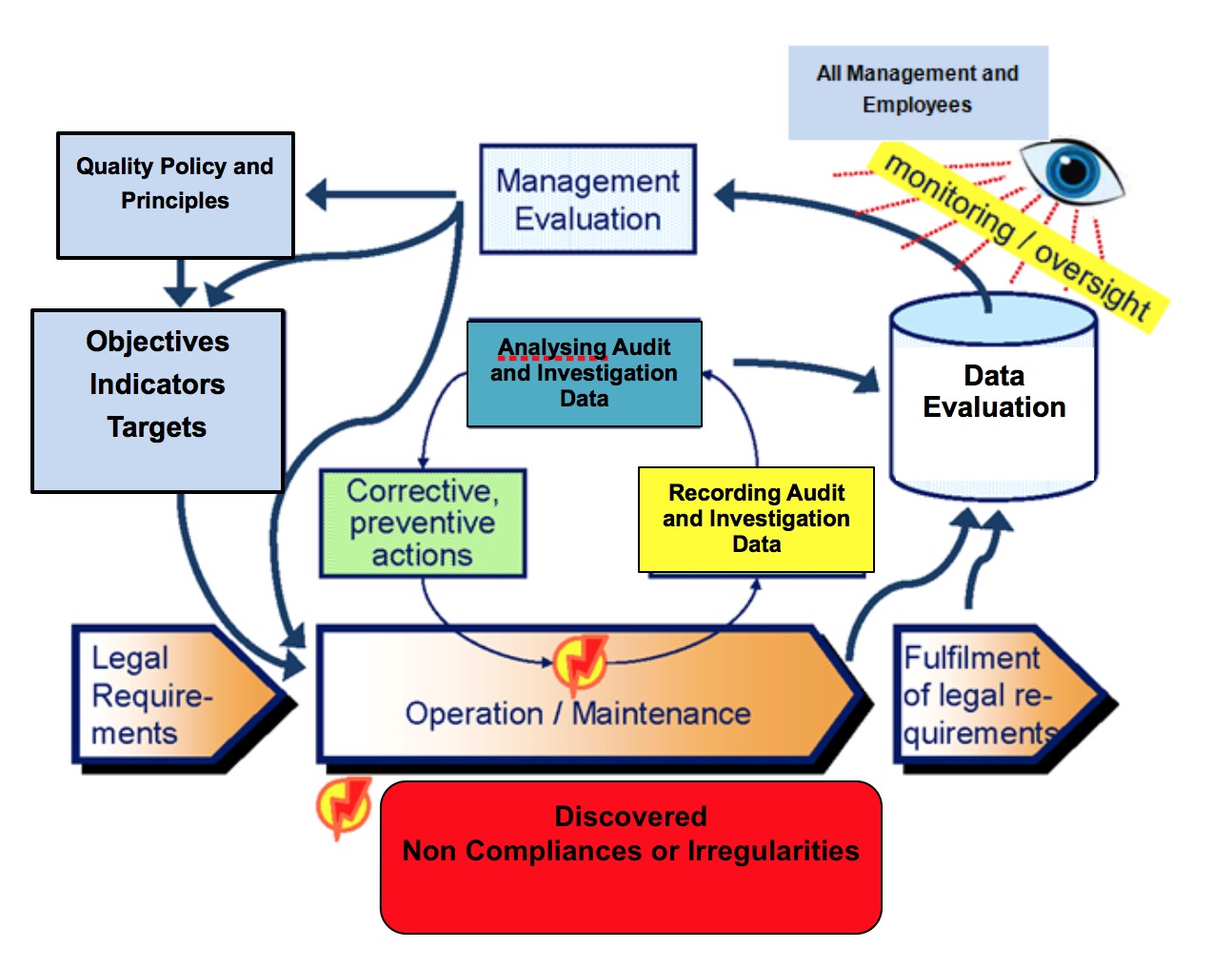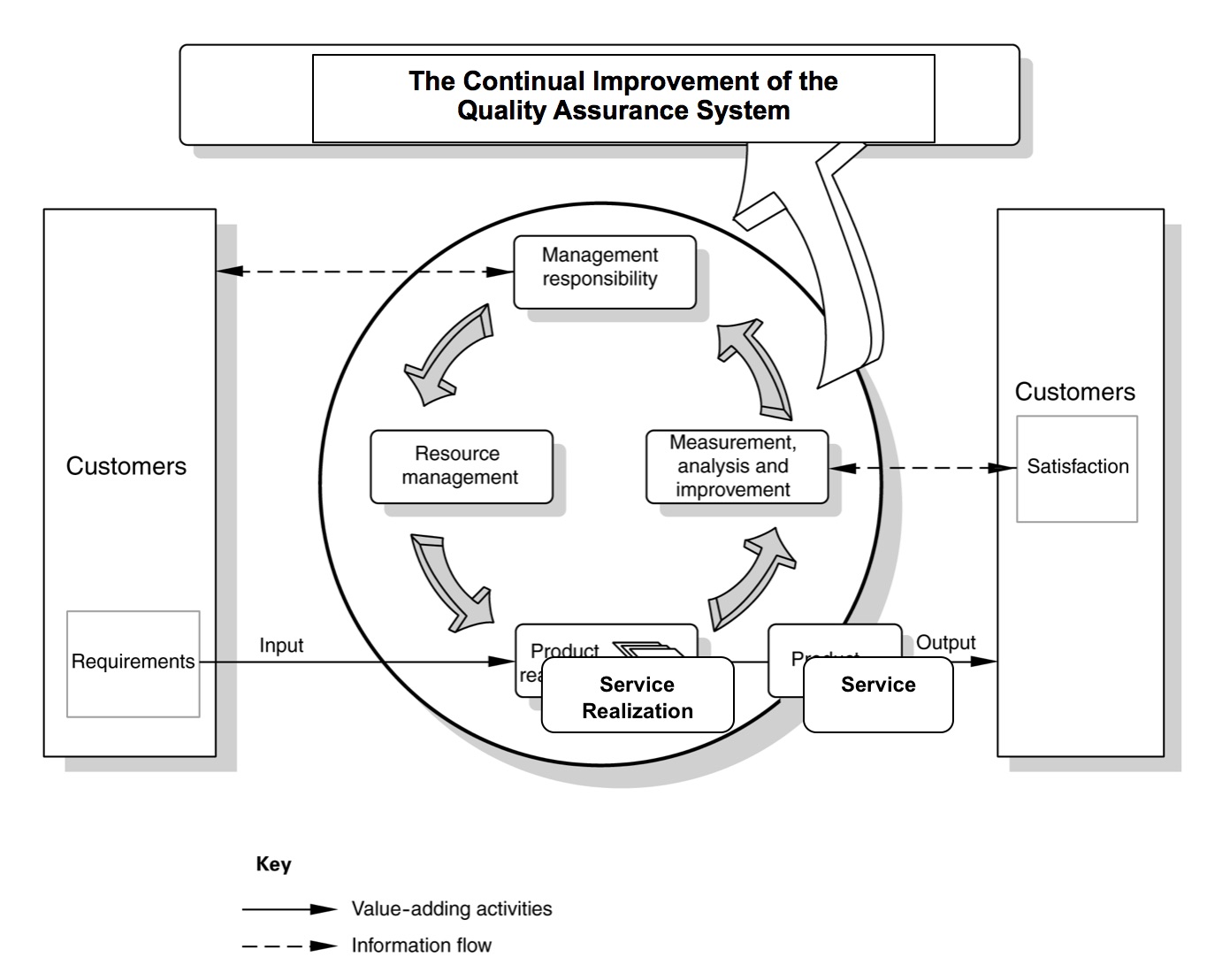
AC Aviation Quality Assurance System¶
ACA’s QAS takes a pro-active, integrated approach to quality assurance. ACA has developed Eight Quality Management Principles that are the basis for our overall quality management process. The Eight Quality Management Principles ensure that the goals of ACA can be accomplished at the highest levels of quality and safety.
ACA’s Quality Assurance System (QAS), Compliance Monitoring System, (CMS) and Safety Management System, (SMS) overlap. The QAS, CMS and SMS are all designed to identify risk and non-compliant areas. Audits and inspections accompanied with a compliance monitoring processes ensure that all operations can be carried out in such a way as to minimize the risks inherent in the aviation industry. ACA embraces the principle that the identification of non-compliant areas within our operations and by correcting non-compliant areas will increase the level of quality and thus increase safety.
ACA’s Eight Quality Management Principles¶
Principle 1 – Customer Focus¶
ACA depends on our customers and therefore understands current and future customer needs, should meet customer requirements and strive to exceed customer expectations.
Principle 2 – Leadership¶
All Nominated Persons shall establish unity of purpose and direction of ACA. They will create and maintain the internal environment in which employees can become fully involved in achieving the organization’s objectives.
Principle 3 – Involvement of Employees¶
Employees at all levels are the essence of ACA and their full involvement enables their abilities to be used for ACAs benefit.
Principle 4 – Process Approach¶
Desired results are achieved more efficiently when activities and related resources are managed as a process.
Principle 5 – System Approach to Management¶
Identifying, understanding and managing interrelated processes as a system that contributes to ACA’s effectiveness and efficiency in achieving its objectives.
Principle 6 – Continual Improvement¶
Continual improvement of ACA’s overall performance is a permanent objective of the ACA.
Principle 7 – Factual Approach to Decision Making¶
Effective decisions are based on the analysis of data and information.
Principle 8 – Mutually Beneficial Contract Service Provider Relationships¶
ACA and its suppliers are interdependent of each other and thus have a mutually beneficial relationship that enhances the ability for both organizations to create value.
The Links between Quality Assurance System and other ACA Quality Components¶
The Continuous Quality Assurance System Monitoring Process¶
Continuous Improvement of the Quality Assurance System¶
We are committed to continually improving our QAS and our overall level of quality. Actions that we will take to achieve continual improvement include the following:
- Analyze and evaluate the existing situation to identify areas for improvement;
- Establish objectives for improvement;
- Search for solutions to achieve the objectives;
- Evaluate solutions and make a selection;
- Implement the selected solution;
- Measure, verify, analyze and evaluate results of the implementation to determine that the objectives have been met ;
- Formalizing changes.
Quality Assurance System Overview¶
The primary purpose of our quality assurance process is to assure the performance and effectiveness of our quality controls.
The primary purpose of our quality assurance process is to assure the performance and effectiveness of our quality controls.
ACA’s quality system includes:
- Quality performance indicators;
- Quality performance targets;
- Audits;
- Inspections;
- Data analysis;
- Gap analysis;
- Quality Promotion;
- Continued Airworthiness;
- Documentation;
- A Quality Assurance Committee;
- A Quality and Compliance Monitoring Systems Assessment;
- The Management of Change;
- A Compliance Monitoring System.
Quality Performance Indicators¶
Quality Performance Indicators (QPI) are a measure used to express the level of quality performance achieved in a system. These are generally expressed in terms of the frequency of occurrence of some event causing a failure of a process, policy or procedure that may cause the cancelation of a flight by the customer. Typical measures that could be used include:
- Cancelations per 1,000 operations hours, or
- Lost or damaged customer baggage per 1,000 aircraft movements
ACA establishes a number of key QPIs to enable the level of quality performance to be monitored and reported over time.
Performance Analysis Trend Analysis¶
The trend analysis shall provide information relating to:
- Customer satisfaction;
- Customer feedback;
- Conformity to product requirements;
- Characteristics and trends of processes and products including opportunities for preventive action;
- Contractor, Vendor and Supplier safety;
- Cost affectivity.
The input to the analysis shall include information on:
- Results of audits;
- Results of inspections;
- Submitted non-compliance, Form QAS-1 and quality related Suggestion Forms;
- Process performance and product conformity;
- Status of preventive and corrective actions;
- Follow-up actions from previous management reviews;
- Changes that could affect the safety management system; and
- Recommendations for improvement.
The trend analysis is based on audit/inspection trend monitoring, the prescribed maintenance and flight operational occurrence reports and daily information received by the safety personnel.
The analysis data will be separated according their origin:
- Maintenance, Part M or flight operations findings affecting the CAAT requirements; and
- Occurrences affecting the company safety standards.
The Head of Quality will monitor the action responses to adverse trends to ensure the trends are being reversed and are under management control.
The Head of Quality will assess the reports and records of non-compliance annually and produce a report, highlighting any adverse trend. The report will be distributed for review to the Quality Assurance Committee and Board of Directors.
Quality Performance Targets¶
The Quality Assurance Committee shall decided and constantly evaluate the appropriate quality performance indicators, an acceptable quality performance targets. Targets must be designed to promote reporting and safety performance improvement. Trend analysis will support the setting of targets and indicators, through the provision of statistical analyzed data.
Audits¶
An audit is a scheduled and a formal review to evaluate compliance with ACAs quality standards for our processes, policies, procedures, and contractual requirements. ACAs audits may also include compliance monitoring. A compliance monitoring audit will be conducted to ensure compliance with CAAT requirements. The main purpose of an audit is to identify unsatisfactory practices before they cause an accident. Audits will be carried out in accordance with the Audit Schedule.
Inspections¶
An inspection is unscheduled or unannounced check of ACA departmental operations or our contract services providers operations. The inspection confirms that ACA or our contract services provider’s processes, policies or procedures are compliant with ACA standards.
Data Gathering¶
Data is gathered during an audit or an inspection. The data will be submitted to the Head of Quality and the Quality Assurance Committee for analysis.
Data Analysis¶
Data analysis is a critical component of ACA’s QAS. Submitted data from employees, auditors and inspectors will be evaluated and compared to ACA’s quality performance indicators and targets. Over a period of time, this data will help identify indicators that point to potential problems in the system before they occur.
Gap Analysis¶
We have made efforts to incorporate quality into all ACA policies and procedures. Reviewing our existing processes, policies and procedures can expose gaps in or in or processes and therefore offer opportunities for improvement.
Quality Promotion¶
Quality Promotion refers to activities undertaken by our organization to promote a positive quality culture, to communicate the outputs of our QAS, and to ensure the application of quality lessons learned in order to foster the continuous improvement of quality in our operations.
Quality Promotion is accomplished in the following ways:
- Employee Quality Training;
- Monthly Quality Bulletins and Notices distributed to ACA employees by the Head of Quality;
- Quality Meeting that are conducted each week by department managers or supervisors.
ACA is committed to ensuring that all personnel are informed about our quality polices and goals, how well we are meeting those goals, results of accident and incident investigations, new quality practices, and other matters dealing with quality.
The Head of Quality has been assigned the responsibility to ensure that the duties of this section are accomplished.
Continued Airworthiness¶
ACA will meet the Continued Airworthiness Quality Assurance System requirements of CAAT and will carry out a Quality Audits to ensure that we are meeting maintenance quality requirements for continued airworthiness of ACA aircraft. Audits will be carried out at least once a year in order to review all aspects of continuing airworthiness activities within a period of 12 months.
Additional maintenance audits will be carried out:
- Whenever corrective action has to be performed before the next scheduled audit.
- When maintenance procedures are newly established or revised.
- Upon changing or adding a different type of aircraft to the ACA fleet.
- Upon changing of the Airworthiness or Head of Quality.
- Before using a repair station as a contract service provider for airworthiness management or maintenance.
Note
See the yearly Quality Audit Schedule for all scheduled quality audits.
Documentation¶
ACA’s QAM documents the following aspects of ACA’s Quality Assurance System Program:
- Scope of the quality management system;
- Quality process, policies, procedures and objectives;
- Objectives, quality indicators and resources;
- Analyzing non-compliance areas that are determined to be quality related;
- Recording of non-compliance areas that are determined to be quality related;
- Corrective and preventive actions;
- Management evaluation;
- Quality performance monitoring;
- Quality compliance monitoring;
- Management of change;
- Quality assurance auditing and inspections; and
- Quality promotion.
The Quality Assurance Committee¶
ACA has formed a Quality Assurance Committee in order to assist the Head of Quality and the Head of Flight Operations with the decision making process regarding ACA’s overall quality processes, policies and procedure.
Through this committee, the implementation of ACA’s quality processes, policies and procedure that have been established accordance with ACA; standards, policies and recommended practices will be deliberated and shall ensure a higher level of quality is achieved.
The Accountable Manager chairs the Quality Assurance Committee Meetings.
The Head of Flight Operations will act as Secretary of the Quality Assurance Committee Meetings.
The Quality Assurance Committee will consist of the following ACA management personnel:
- The Accountable Manager;
- The Head of Flight Operations;
- The Head of Quality;
- The Head of Safety;
- The nominated Secretary for the meeting;
- The Chief Pilot;
- The Head of Engineering;
- Any nominated Senior Flight Crew Members;
- Any nominated Senior In-Flight Service Representatives;
- Any nominated Dispatch Personnel;
- Any department employees that wish to attend or are invited to attend;
- Inspection team members that are currently conducting an audit.
- Audit team members that are currently conducting an audit.
Quality Assurance Committee Focus¶
The focus of ACA’s Quality Assurance Committee will be on proactive “action”, as opposed to “dialogue”. The role of the Quality Assurance Committee will also:
- Act as a source of expertise and advice on quality matters to senior management;
- Evaluate all ground and flight operations that ACA is considering and evaluating the risk(s) involved;
- Evaluating existing ground, flight and training processes, policies and procedure and re-assessing the risk(s) involved;
- Review the progress on identified quality concerns and actions taken following accidents and incidents;
- Review the following submitted reports and make recommendations to
improve safety and or quality;
- Non-compliance Reports, Form QAS-1
- Suggestion Reports;
- Audit and Inspection results.
- Address and make recommendations to resolve all quality concerns.
Note
If there is not sufficient time to cover all items on the agenda, then additional meetings will be scheduled to cover any remaining items.
Quality Assurance System Assessment¶
Once a year the Quality Assurance Committee will evaluate the overall effectiveness of ACA’s QAS program. The Quality Assurance Committee will enlist the assistance of qualified and approved contracted individuals or contracted organization for this purpose.
Whereas ACA’s internal audits or inspections are used to obtain objective evidence that existing policy, procedures or requirements have been met, the information obtained through a contracted qualified and approved contracted individuals or contracted organization will offer a fresh set of eyes on our operations and therefore bring quality issues to light that ACA’s internal audits or inspections may overlook.
The QAS assessment will be used to benchmark it check ACA’s performance against the overall aviation system-wide goals and the best practices of the aviation industry. These results will then be used to improve the performance of ACA.
The Quality Assurance Committee will conduct an annual QAM review meeting which occurs in the month of June.
The Management of Change¶
When a corrective action is approved by the Quality Assurance Committee the approved change will be implemented in accordance with the following procedures:
- The change process including the risk assessment by the Quality Assurance Committee, will be recorded,
- The amended process, policy or procedure will be distributed to all Nominated Persons by e-mail by the Head of Quality as describe in the revision section of all affected manuals or documents;
- The Quality Assurance Manual and other associated documentation will be revised or amended by the responsible Nominated Person and then distributed to Quality Assurance Manual and other associated documentation holders.
Prior to undergoing any significant change that could impact ACA operations, a management change process will be undertaken by the Quality Assurance Committee.
Examples of change that will trigger a need for such a management change process are:
- The introduction of a new aircraft type;
- Significant change in the nature of the operation (e.g. dynamic business growth, new operating environment, etc.);
- Changes in hiring or scheduling practices;
- Changes to organizational structure;
- Operating and maintenance procedures and processes;
- Personnel training and competency certification;
- ACA’s Operations Manual;
- Maintenance Control Manual or Maintenance Procedures Manual;
- Aircraft SOPs, etc., and a plan for development of the required changes.
- Significant change in aircraft maintenance arrangements, etc.
As soon as it has been determined that the change event will occur, a risk assessment will be conducted on the pending policy change by the Quality Assurance Committee. On the basis of that assessment, and any other available information, the Quality Assurance Committee will develop an implementation plan. The implementation plan that has been agreed upon by the Quality Assurance Committee will include a risk analysis of the change event and an assessment of the changes required.


